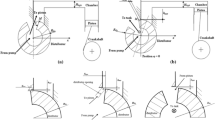Abstract
Many studies on cavitation phenomena were based on the theory of single bubble motion which was first put forward by Rayleigh in his 1917 article and later developed by Plesset et al.[1]. By this theory, only some effects of forces were taken into consideration from hydrodynamics leaving out any thermodynamical effects such as matter interchange between liquid and gaseous phases. Strictly speaking, the theory may be suitable for discussing expansior or/and contraction motion of a bubble formed in liquid, but this theory does not cope with cavitation behaviors in general. In this paper, the cavitation conditions and similarity problems are discussed with thermodynamic effects taken into consideration in addition to the hydrodynamic ones.
Similar content being viewed by others
References
Lamb, H., Hydrodynamics, (1924), 114–115.
Knap, R.T., J.W. Daily and F.G. Hammitt, Cavitation, (1970), 76–77.
Hammitt, F.G.,Cavitation and Multiphase Flow Phenomena, (1981), 144–145.
Arndt, Roger, E.A.,Recent Advance in Cavitation Research, Section II. (1980).
Wang Zhu-xi,A Concise Course of Thermodynamics, (1964), 107–108, 155–156, 189–193, 199, 209–210, (in Chinese)
Wang Zhu-xi,Introduction to Stochastical Physics, 186. (in Chinese)
Haung, Francis, F.,Engineering Thermodynamics Fundamentals and Applications, (1973). (in Chinese)
Qian Xue-sen,Lecture Notes on Physical Mechanics, 285. (in Chinese)
Author information
Authors and Affiliations
Rights and permissions
About this article
Cite this article
Shu-tang, T., Yi-xin, L. Thermodynamics on cavitation. Appl Math Mech 4, 825–831 (1983). https://doi.org/10.1007/BF01896169
Received:
Issue Date:
DOI: https://doi.org/10.1007/BF01896169



